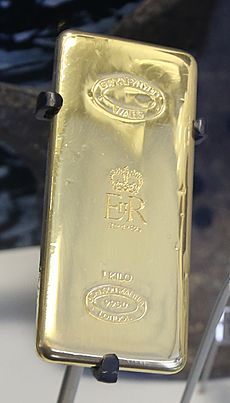Welsh gold facts for kids
Welsh gold is a special type of gold found naturally in Wales. It's not chemically different from other gold, but it's highly valued because it's rare and comes from Wales.
In North Wales, gold is often found in a stretch of land from Barmouth to Dolgellau and up towards Snowdonia. The biggest mines there were Gwynfynydd Gold Mine and Clogau Gold Mine.
In South Wales, gold is found in a small area near the River Cothi at Dolaucothi. The Romans mined gold here a very long time ago.
Ancient gold items have been found in Wales. These include the Mold Cape and the Banc Ty'nddôl sun-disc. These items show that people in ancient Wales used gold for beautiful jewellery. It's hard to know if these items were made from Welsh gold or gold traded from places like Ireland. Ireland was a big centre for gold work during the Bronze Age.
Contents
Dolaucothi Gold Mine: A Roman Story
The Dolaucothi Gold Mines near Pumsaint in Carmarthenshire are the oldest known gold mines in Wales. The Romans started mining here around 74 AD. The mine later closed in 1938. In 1941, it was given to the National Trust.
The Romans mined a lot of gold at Dolaucothi from about 75 AD to at least 300 AD. They used clever methods like hydraulic mining, which uses water to wash away soil and rocks. They also used fire-setting, where they heated rocks with fire and then quickly cooled them with water to make them crack.
A small Roman fort was built near the village of Pumsaint to control the mining. Many Roman pots have been found near a water storage area called "Melin-y-milwyr," which means "soldiers' mill."
Today, the Dolaucothi mine is open to visitors. You can explore the old mining areas and even go on a tour of the underground tunnels.
Gold Mines of North Wales
Gwynfynydd Gold Mine
The Gwynfynydd Gold Mine in Dolgellau stopped mining in 1999. In 2007, news reports said that all the gold that could be easily taken out had been removed. They even checked the local road surface for tiny bits of gold!
Gwynfynydd mine was found in 1860. It was active until 1998 and produced a lot of gold. In 1986, a 1-kilogram bar of gold from this mine was given to Queen Elizabeth II for her 60th birthday.
In the 1990s, the mine offered tours where people could even try to pan for gold themselves. It closed because of safety rules and new laws about pollution. In 2016, the Welsh jewellery company Clogau bought the Gwynfynydd mine.
Clogau Gold Mine
Another important gold mine nearby is the Clogau Gold Mine. It's also known as Clogau St David's Mine. It's located in Bontddu, near Barmouth, in Gwynedd. This mine was once the biggest and richest gold mine in the Dolgellau area.
The Clogau mine first produced copper and a little lead. Then, in 1862, a "gold rush" started, and it became a major gold producer until 1911. During that time, it produced over 78,500 troy ounces of gold.
The mine worked alongside the Vigra Mine. After 1911, it opened a few more times for smaller mining efforts. It last closed in 1998.
In 1989, William Roberts, who started the Welsh jewellery brand Clogau, got the rights to mine there. He did some small-scale mining until 1998. The mine closed because it was very expensive to get the gold out, and less and less Welsh gold was being found.
How Welsh Gold Compares
Welsh gold is found in veins of rock. These veins can contain a good amount of gold, sometimes up to 30 troy ounces for every long ton of ore. To compare, gold ore from South Africa usually has only about a quarter of a troy ounce per tonne. However, the gold fields in South Africa are much, much larger.
Welsh Gold and the Royal Family

Welsh gold has a special connection to the British royal family. This link began on July 13, 1911. On that day, Prince Edward was officially made Prince of Wales at Caernarfon Castle. The special items used in the ceremony, like his crown and ring, included Welsh gold.
Later, on July 1, 1969, Prince Charles was also invested as Prince of Wales at Caernarfon Castle. The same special items with Welsh gold were used.
Welsh gold has also been used to make wedding rings for many members of the Royal family.
- Elizabeth Bowes-Lyon (Queen Elizabeth The Queen Mother) used a Welsh gold ring for her wedding in 1923.
- Queen Elizabeth II's wedding ring was made from Welsh gold from the Clogau St. David's mine.
- Other royals who have worn Welsh gold wedding rings include Princess Anne (1973), Diana, Princess of Wales (1981), King Charles III (1981 and 2005), Catherine, Princess of Wales (2011), Meghan, Duchess of Sussex (2018), and Princess Eugenie (2018).
Images for kids
-
The Bronze Age Burton Hoard, found in Burton, Wrexham. The gold items include a folded torc, a twisted bracelet, a necklace pendant, beads, and rings.
See also
- Irish gold
- Scottish gold



